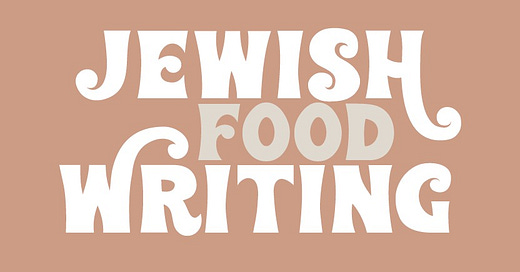Jewish Food is a nuanced subject. It’s more than anything we know. In fact, Esther David’s book, Bene Appétit, the Cuisine of Indian Jews, only came out in 2021, published in India by Harper Collins! We are still just learning about the beautiful Jews of the Igbo community in Nigeria, and widening our understanding towards Jews of color, as a whole.
But, basically, in my best “Melissa-speak”, Jewish food is food that originated in a specific place, eaten by ancient Israelites—an agrarian people taking part in a lunar cycle, with dietary restrictions and seasonal foods for certain holy days and festivals.
I also think of the memory of and longing for certain foods that traveled within the heart of Jews as they were taken into Babylonian Exile, also to Egypt and out of Egypt, (more poetically written than chronologically), through Persia, France, Germany, to the Iberian Peninsula, into the Orient, those that fled Iraq or Libya, in and out of shifting politics and hateful pogroms centered on casting out or killing Jews. It is bringing the Old World to the New World again and again, emerging vibrant even surviving a final “solution” to be wiped off the earth, but living in community with the dishes that resonate with history. It’s creativity, flexibility, and hope.
The new retro-vibe logo made by my sis, Mackenzie Rifkin. Talent.
It’s me writing about the need for Grandma Tessie’s mushroom barley soup in my deepest season of need. It’s discovering that mugi/barley is here in Japan and I can choose from a whole wall of mushrooms, finally quenching the haunt of heritage and the longing of memory.
It’s looking into the sabich sandwich (link to Saveur’s piece) and seeing all of the nations represented there, in this Iraqi sandwich born in the Tel Aviv neighborhood of Ramat Gan. What I would do for the fried eggplant, spicy zhoug/a Yemenite sauce of hot peppers, the egg, and amba/mango chutney! Here is the Jewish Food Society’s “Schmaltzy” recording, writing, and recipe. They are certainly gifted experts in the field.
Food is the evidence and the scattered “breadcrumbs” telling the story of where we’ve been and how we lived.
Images From Bene Appétit, by Esther David
Jewish Food is not just pastrami, clearly. It’s not only fancy 12-strand challah loaves or even the secret adafina meals of Spanish/Sephardic Jews living in fear of Inquisition. My non-math brain cannot even wrap itself around how ancient, how well-established these customs and dishes have been in place, in the soul of a people, moving with us again each time it was no longer safe.
We’d need a flux capacitor to even dip into the breadth of “What Jewish Food Is”.
52 Shabbats, by Faith Kramer, a book I’ve excitedly ordered. It’s history and recipe.
Jewish food spans the globe. It’s here with me now in Tokyo. It’s within the Jewish community of Hong Kong and in Argentina, in Montreal, and yes, in New York Delicatessens.
Check out this Tablet Magazine piece by Joan Nathan entitled “Ethiopian Jews’ Version of Friday Night Dinner”. Or this piece in Whetstone Magazine, “What is Jewish Food?” by Joe Bauer.
I just read a fascinating conversation at The Counter, a between Charlotte Druckman and Rebecca Flint Marx, publishers of food journalism in America, about the topic of “Jewish Identity Through Contemporary Cookbooks”. The Counter published this piece the same month (May, 2022) they’ve announced folding. I’m grateful for the timing, but what a loss. How’s this Palm-Beachy cookbook cover?
Before they shared their reactions towards contemporary Jewish cookbooks like 52 Shabbats by Faith Kramer, Modern Jewish Cooking by Leah Koenig, and Eat Something: A Wise Sons Cookbook for Jews Who Like Food and People Who Like Jews by Evan Bloom and Rachel Levin, they first asked this (in turning their attention to Koenig’s book:
“How does a food become Jewish? I can’t answer that question. But this is the question on my mind when I look at this recipe of really nice-looking pan-roasted turnips. I certainly don’t object to it being there. I like that it’s there. If you’ve tasked yourself with making a quote unquote modern Jewish cookbook, you’re going to be looking for vegetable-forward recipes like turnips or fennel. It takes on the popular perception of Jewish food as being like, heavy and beige and outdated”.
—Rebecca Flint Marx
Also, Jewish food can look very different, not just according to where one lives out their Jewish life, say in Miami Beach, Seoul, or Oregon, but also depending on how observant one follows Jewish dietary laws. We all have our unique backgrounds and views on what adds to our Jewish lives. Food is such a fantastic way to glimpse these tangible variables at play.
My daughter so psyched to get her felafel on, at Taim, in Ebisu, Tokyo.
“People are coming to the concept of Jewishness with very different ideas, so the way one person writes about a product might be very deeply tied to a holiday or a renewal, while others may be talking about it in a completely secular way.”
– Rebecca Flint Marx
What’s next?
Interviews! I’ve got the Jewish Food Writing Podcast coming up soon, with music, design, so much help by my friends and sister. I’ve got splashes of brilliant conversations though text and audio, with the most genius creators and authors.
Recipes! I’ll be adding one recipe per month to start.
You’ll see my own Japanese-influences, my South Florida identity at play, and diversity. We are not only stuck with making brown food, but taking our cues from the holidays or moedim, and using the best of each season, the best of our memory, creativity, and what’s available where we are, to make the food that moves from generation to generation.
Whether you, yourself, are Jewish or not, this is about ancient grains, surviving flavors, and the meals and conversations to help you, as one close friend puts it, “linger at the table”.









